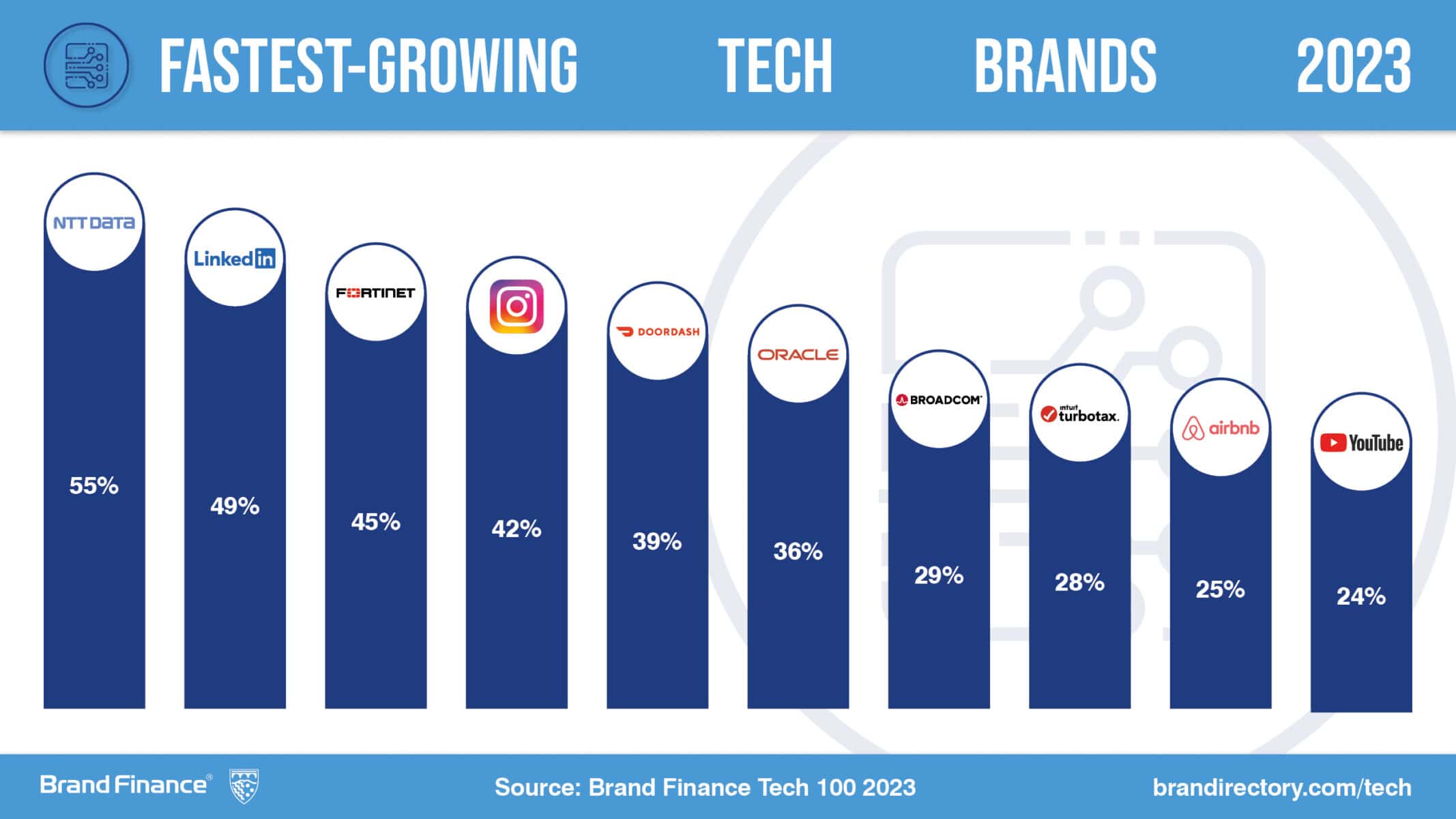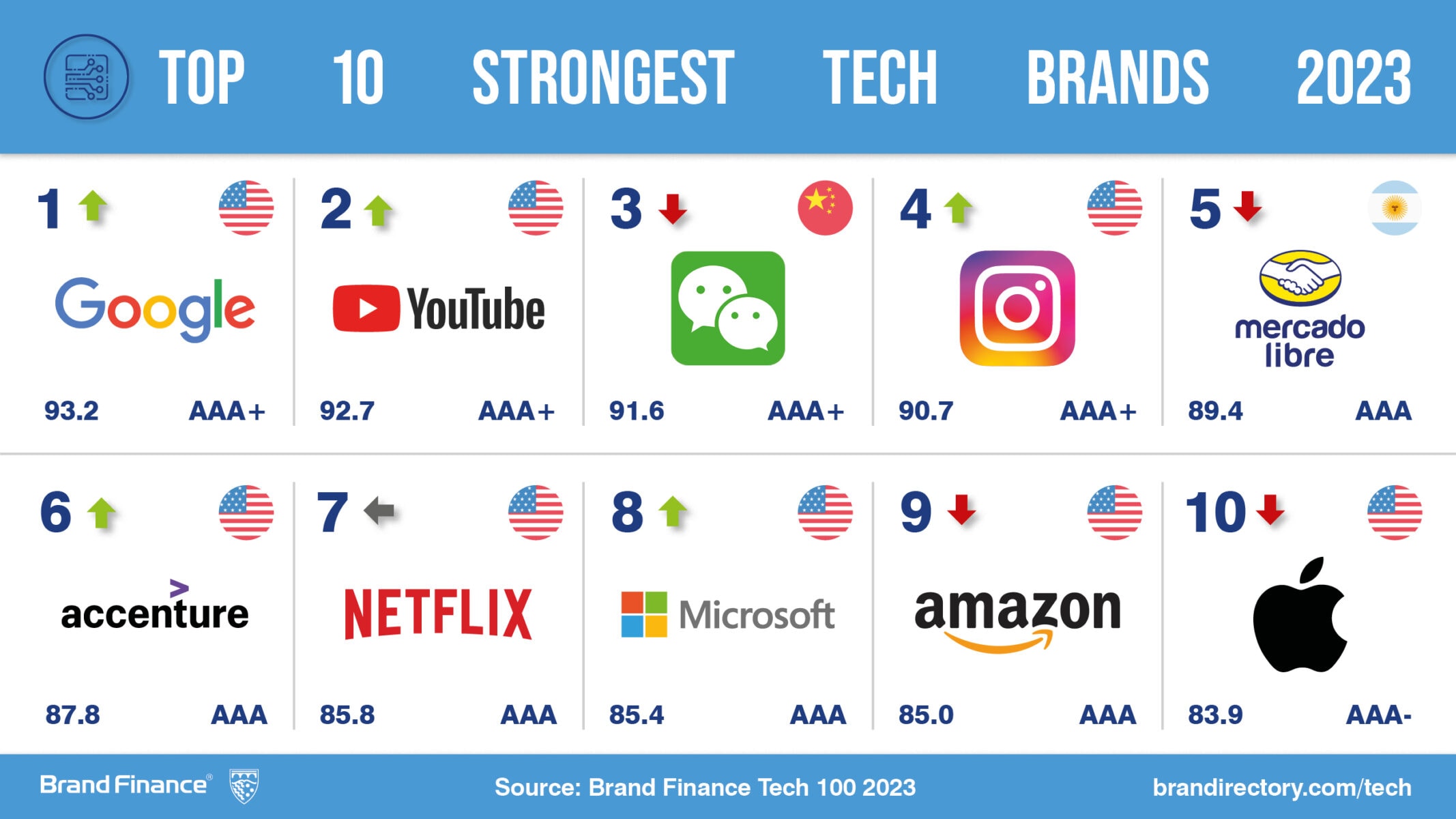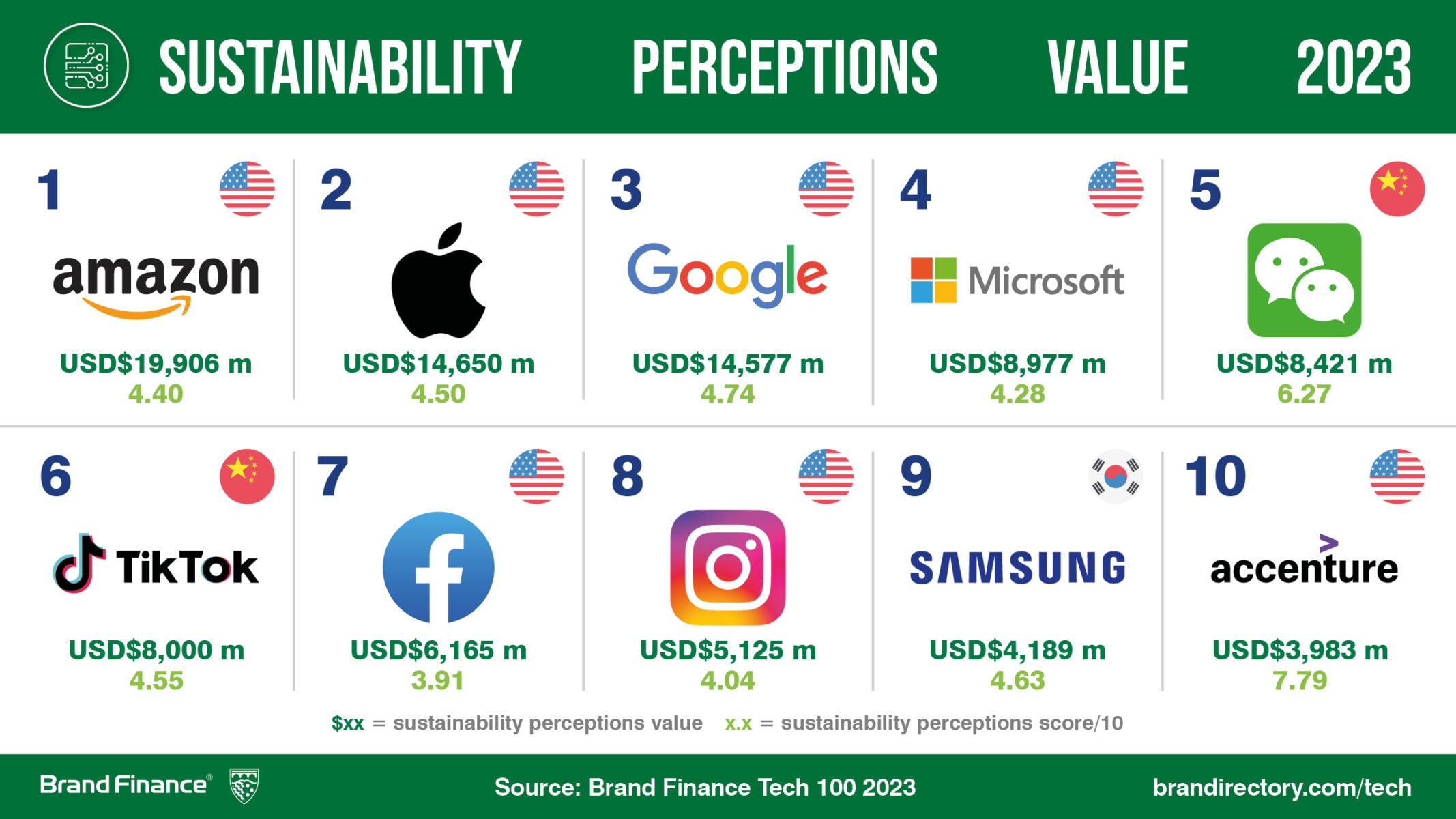View the full Brand Finance Tech 100 2023 report here
Amazon has overtaken Apple to become the world’s most valuable tech brand, with a brand value of USD299.3 billion. Amazon’s brand value has increased 36% since the beginning of the COVID-19 pandemic and is the world’s most valuable brand across all sectors, according to Brand Finance’s Global 500 2023 report.
Every year, leading brand valuation consultancy Brand Finance puts 5,000 of the biggest brands to the test, and publishes over 100 reports, ranking brands across all sectors and countries. The world’s top 100 most valuable and strongest tech sector brands are included in the annual Brand Finance Tech 100 2023 ranking.
Richard Haigh, Managing Director of Brand Finance commented:
“The global dominance of Amazon as the world’s leading tech brand cannot be ignored. The brand’s relentless pursuit of customer-centric innovation has not only transformed the way we shop but has challenged and overhauled traditional business models. The tech giant must now look to maintain its competitive edge amid the rapidly evolving landscape, especially as eyes are on the brand now more than ever.”

Japan’s NTT DATA (brand value up 55% to USD8.9 billion) is the fastest-growing tech brand in the ranking this year. This is because NTT Corporation and NTT DATA formally integrating their offerings more closely and launching a combined brand to accelerate global IT modernization and digital transformation. This is a new beginning for the NTT DATA brand that looks to accelerate growth outside of Japan and further increase its diverse digital services and application offering to clients.
Elsewhere, LinkedIn (brand value up 49% to USD15.5 billion) is the tech sector’s fastest-growing brand, substantially because of its improved standing as a recruitment and news advertising tool.

Despite facing headwinds from global political challenges, the semiconductor shortage, and a global slump in demand for smartphones, Huawei remains in the top ten most valuable tech brands, with its brand value falling 38% to USD44.3 billion. Huawei's consumer business, which provides smartphones, tablets, and other consumer electronics, was the hardest hit by the various challenges. However, the brand’s other operations, such as its carrier business and its enterprise business, performed relatively well.
In addition to calculating brand value, Brand Finance also determines the relative strength of brands through a balanced scorecard of metrics evaluating marketing investment, stakeholder equity, and business performance. As well as being the strongest brand in the United States, and the world, Google (brand value up 7% to USD281.4 billion) tops the tech ranking, earning a brand strength index score of 93.2/100 and a prestigious AAA+ rating.

As part of its analysis, Brand Finance assesses the role that specific brand attributes play in driving overall brand value. One such attribute is sustainability. Brand Finance assesses how sustainable specific brands are perceived to be, represented by a ‘Sustainability Perceptions Score’. Accenture had the highest Sustainability Perceptions Score of any Tech brand included in the ranking – 7.79 out of 10. The brand has set out its commitment to operating more sustainably, planning to achieve net zero emissions by 2025.
One key area where Amazon has been making strides is in its renewable energy initiatives. As the largest corporate buyer of renewable energy globally, Amazon is committed to powering all its operations with 100% renewable energy by 2025. To achieve this goal, the brand has already announced more than four hundred projects as of January 2023, highlighting its notable progress in this endeavour. The driver score for the retail sector is 6.1%, demonstrating a material role for sustainability in driving choice. Amazon’s US$19.9 billion of value is reliant on maintaining its reputation for (a certain level of) sustainability.

Brand Finance is the world’s leading brand valuation consultancy. Bridging the gap between marketing and finance, Brand Finance evaluates the strength of brands and quantifies their financial value to help organisations make strategic decisions.
Headquartered in London, Brand Finance operates in over 25 countries. Every year, Brand Finance conducts more than 6,000 brand valuations, supported by original market research, and publishes over 100 reports which rank brands across all sectors and countries.
Brand Finance also operates the Global Brand Equity Monitor, conducting original market research annually on 6,000 brands, surveying more than 175,000 respondents across 41 countries and 31 industry sectors. By combining perceptual data from the Global Brand Equity Monitor with data from its valuation database — the largest brand value database in the world — Brand Finance equips ambitious brand leaders with the data, analytics, and the strategic guidance they need to enhance brand and business value.
In addition to calculating brand value, Brand Finance also determines the relative strength of brands through a balanced scorecard of metrics evaluating marketing investment, stakeholder equity, and business performance, compliant with ISO 20671.
Brand Finance is a regulated accountancy firm and a committed leader in the standardisation of the brand valuation industry. Brand Finance was the first to be certified by independent auditors as compliant with both ISO 10668 and ISO 20671 and has received the official endorsement of the Marketing Accountability Standards Board (MASB) in the United States.
Brand is defined as a marketing-related intangible asset including, but not limited to, names, terms, signs, symbols, logos, and designs, intended to identify goods, services, or entities, creating distinctive images and associations in the minds of stakeholders, thereby generating economic benefits.
Brand strength is the efficacy of a brand’s performance on intangible measures relative to its competitors. Brand Finance evaluates brand strength in a process compliant with ISO 20671, looking at Marketing Investment, Stakeholder Equity, and the impact of those on Business Performance. The data used is derived from Brand Finance’s proprietary market research programme and from publicly available sources.
Each brand is assigned a Brand Strength Index (BSI) score out of 100, which feeds into the brand value calculation. Based on the score, each brand is assigned a corresponding Brand Rating up to AAA+ in a format similar to a credit rating.
Brand Finance calculates the values of brands in its rankings using the Royalty Relief approach – a brand valuation method compliant with the industry standards set in ISO 10668. It involves estimating the likely future revenues that are attributable to a brand by calculating a royalty rate that would be charged for its use, to arrive at a ‘brand value’ understood as a net economic benefit that a brand owner would achieve by licensing the brand in the open market.
The steps in this process are as follows:
1 Calculate brand strength using a balanced scorecard of metrics assessing Marketing Investment, Stakeholder Equity, and Business Performance. Brand strength is expressed as a Brand Strength Index (BSI) score on a scale of 0 to 100.
2 Determine royalty range for each industry, reflecting the importance of brand to purchasing decisions. In luxury, the maximum percentage is high, while in extractive industry, where goods are often commoditised, it is lower. This is done by reviewing comparable licensing agreements sourced from Brand Finance’s extensive database.
3 Calculate royalty rate. The BSI score is applied to the royalty range to arrive at a royalty rate. For example, if the royalty range in a sector is 0-5% and a brand has a BSI score of 80 out of 100, then an appropriate royalty rate for the use of this brand in the given sector will be 4%.
4 Determine brand-specific revenues by estimating a proportion of parent company revenues attributable to a brand.
5 Determine forecast revenues using a function of historic revenues, equity analyst forecasts, and economic growth rates.
6 Apply the royalty rate to the forecast revenues to derive brand revenues.
7 Discount post-tax brand revenues to a net present value which equals the brand value.
Brand Finance has produced this study with an independent and unbiased analysis. The values derived and opinions presented in this study are based on publicly available information and certain assumptions that Brand Finance used where such data was deficient or unclear. Brand Finance accepts no responsibility and will not be liable in the event that the publicly available information relied upon is subsequently found to be inaccurate. The opinions and financial analysis expressed in the study are not to be construed as providing investment or business advice. Brand Finance does not intend the study to be relied upon for any reason and excludes all liability to any body, government, or organisation.
The data presented in this study form part of Brand Finance's proprietary database, are provided for the benefit of the media, and are not to be used in part or in full for any commercial or technical purpose without written permission from Brand Finance.